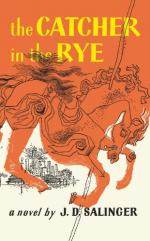|
This section contains 856 words (approx. 3 pages at 300 words per page) |

|
Holden's Perceptions of Childhood's Innocence Versus Adulthood's Complexity
Summary: This essay is an analysis of "The Catcher in the Rye" by JD Salinger. It describes three symbols in the novel- the Museum of Natural History, the image of the "catcher in the rye," and graffiti to show Holden Caulfield's perceptions of the world and his struggles in growing up.
The teenage years are a time of transition between the simplicity of childhood and the complexity and responsibilities of adulthood. Most teenagers eagerly jump into a more adult role, striving to be seen as independent and mature. Childlike naiveté is often shunned and pushed aside at an early age. However, in the novel Catcher in the Rye, by J.D. Salinger, protagonist Holden Caulfield is reluctant to relinquish the safety and comfort of childhood in exchange for the adult world, which he finds frightening and superficial. Holden is fearful that is he lets go of his youth, he will lose his connection with his brother Allie, who died when he was quite young. As a defense mechanism, Holden views the adult world as taboo, to be avoided at all costs, and begins to see it as his responsibility to protect children from its hypocrisy and corruption. Salinger uses...
|
This section contains 856 words (approx. 3 pages at 300 words per page) |

|


